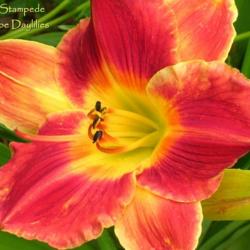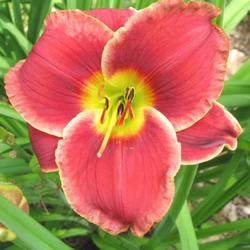re: Tet conversions as prepotent....
At one of the recent Shirley Farmer meetings, some of the top hybridizers (Gossard, Polston, etc.) were discussing the inheritance of traits. One of them made the point that tetraploid conversions are very powerful breeders for carrying on the traits they themselves display. That makes sense since whatever dominant genes they carry for color, edges, or form as a diploid, have been doubled, which greatly increases the chances of them passing on those genes instead of hidden, recessive traits. I would think tet conversions would be called 'prepotent'.
You can see this if you go to the AHS database and look for all offspring of 'Spindazzle' and select for 'tetraploid'. You will be looking at the offspring of the tet conversion. You'll see how many have the basic color pattern and narrow form of Spindazzle. It was even mentioned in the meeting that it's hard to get any colors other than yellow with rust-red or plain yellow even several generations down the line from Spindazzle. (I am not sure if you can do such a search for offspring on the ATP database...I'm a new user and need to familiarize myself with it!)
It has also been mentioned by 'those in the know' that generally speaking, it is easiest to use tet conversions as the pollen parent since the test for conversion often involves the appearance of the pollen under a microscope. The eggs may be diploid, tetraploid, or infertile in an incomplete or unstable conversion. That isn't to say you can't use any specific tet conversion as pod parent, but it may be difficult.
re: line breeding to create 'prepotent' parents...
When you continually select for certain traits and back-cross to parents and/or cross between sibs, you are practicing line breeding....you are outsorting 'undesirable' traits in every generation, coming closer to a strain that breeds true. That would be like the heirloom or 'open pollinated' strains that Maurice referred to above. This is what happens when everyone is looking, say, for a better, deeper purple. Everyone crosses purples to purples, throwing away everything else, or at least not re-breeding them back to the purple line. After a while, you can get a purple that breeds pretty consistently for more like it, within a narrow range of differences.
I have never tested the theory, and it would take several generations, but most textbooks tell you that continual inbreeding (line breeding) with the introduction of no new outside genes will likely lower the vigor of the strain. If this happens, the introduction of new, completely different genes from another strain (say, another line of purple), will result in hybrid vigor. I've always wanted to try out the line breeding, to test this, but don't have the time and space. Would make a great project, though.
BTW - anyone within driving distance of central Ohio should check out the Shirley Farmer meetings. They're open to the public, with a fee to help pay for the room and a lunch. They're really informative for hybridizers and a great chance to rub shoulders with some of the movers and shakers from the Northern Mecca.
Thanks for the great thread, everyone!



